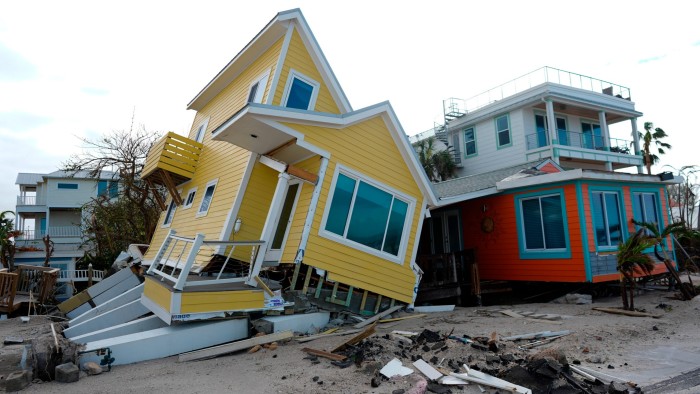Unlock the Editor’s Digest for free
Roula Khalaf, Editor of the FT, selects her favourite stories in this weekly newsletter.
Hedge funds and private investors muscling into reinsurance threaten to destabilise the centuries-old market for catastrophe cover, a director at Munich Re, the world’s biggest reinsurer, has warned.
The growing presence of private investors such as hedge funds and family offices in the sector has intensified competition for dominant players such as Berkshire Hathaway, Munich Re and Swiss Re.
But the sector’s shifting shape has introduced new risks and greater volatility into the reinsurance market, Stefan Golling, a board member of 145-year-old Munich Re, told the Financial Times.
After a big payout event, private investors could lose their nerve, potentially raising the price of insurance, he said.
“In the traditional market, a big hurricane will not be a surprise,” Golling said. By contrast, he added, “capital is getting involved that is not informed in the same way as an underwriting company”.
Hedge funds such as New York’s Elliott Management and specialist fund managers have pushed into property and casualty reinsurance over the past decade. Alternative capital grew to about $115bn at the end of 2024, up from $93bn in 2022, according to broker Aon.
One way is through catastrophe or “cat” bonds, in which insurers pay investors a premium in exchange for covering risks they face. Another is through so-called sidecars — in effect shell companies that take on risk and issue securities to funds run by asset managers.
These new entrants challenged Munich Re and other traditional suppliers of reinsurance capital in a business built on personal relationships cemented at the industry’s annual conference in Monaco.
Golling said it was a good thing that private entrants were helping to meet the world’s growing need for insurance, which has boomed as inflation, population growth and climate change increase the bill for natural disasters.
However, he questioned whether the newcomers fully understood the risks they had taken on.
“We haven’t seen a 50-year or 100-year event that has exhausted the cat bond market,” Golling said. “It has to be seen whether the capital that backs up those cat bonds will reconsider their strategy after such an event.”
He added that the market had already glimpsed the destabilising effects of a retreat by private reinsurance capital after Hurricane Ian hit Florida in September 2022 — just as insurers kicked off renewal negotiations.
Private investors’ uncertainty about the losses they faced threw the availability of some top layers of reinsurance into doubt, prompting some to withdraw and “stressing” the market, Golling said.
Reinsurance prices charged by both traditional and private capital firms subsequently jumped.
Golling also criticised private capital for only signing up to cover the most statistically improbable risks, such as megastorms that are expected every few decades, rather than more common events such as hail.
Critics have long raised similar grievances about Munich Re and its peers.
Insurers and governments complain that traditional reinsurers pull back by raising prices after losses — ultimately driving up costs for consumers — and seek to avoid more frequent perils.
Golling suggested that when traditional reinsurers raise prices, it is to enforce strict underwriting standards at the first port of call for policyholders — the primary insurers — that could otherwise jeopardise the long-term profitability of the sector.
“You have to feel the pain yourself,” he said. “That’s the reason why reinsurance companies have tried to increase the retention [deductible] of the primary insurance companies.”




